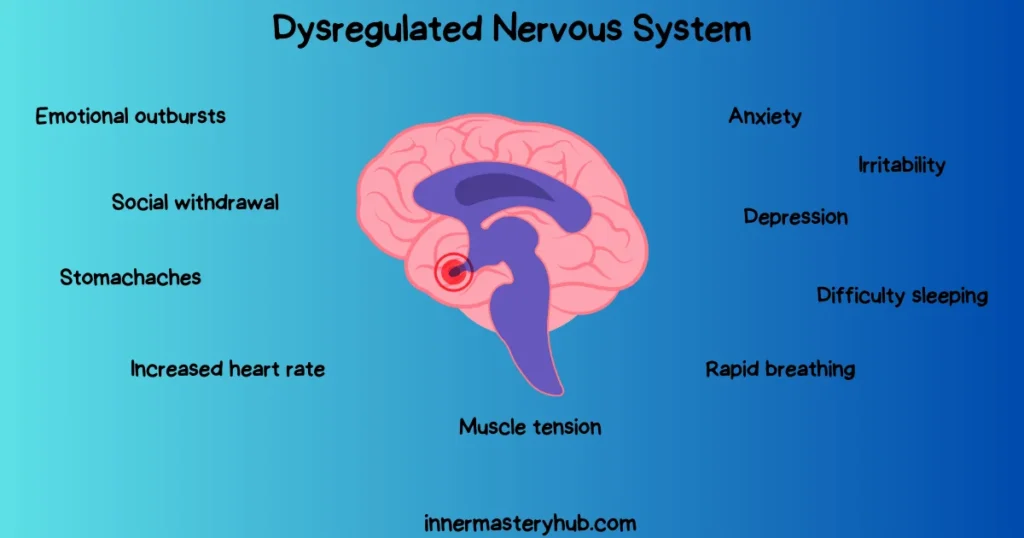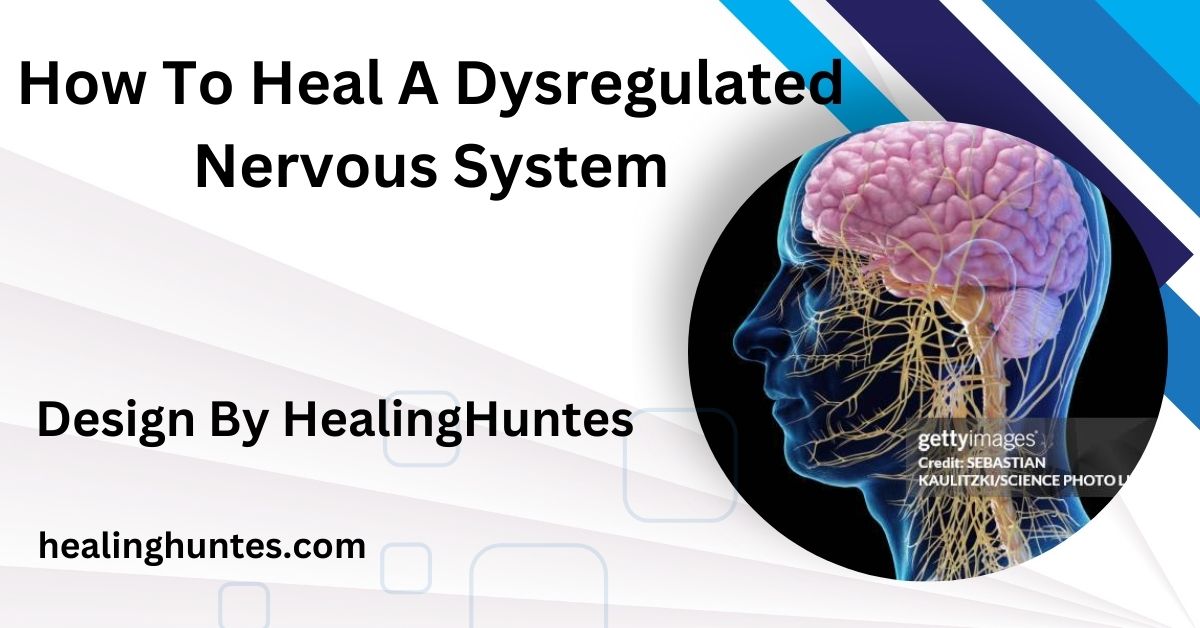How To Heal A Dysregulated Nervous System – Nervous System Recovery
To heal a dysregulated nervous system, engage in breathwork, mindfulness, gentle exercise, good nutrition, quality sleep, and social connections. Consistency is key for long-term balance.
In this guide, you’ll find practical, science-backed methods to support your nervous system- , reduce stress, and promote long-term resilience.
What is Nervous System Dysregulation?

Nervous system dysregulation happens when the body stays stuck in a “fight-or-flight” or “freeze” response due to prolonged stress or trauma. This state can lead to anxiety, depression, chronic fatigue, irritability, and even physical symptoms like digestive issues and muscle tension.
Key Symptoms of a Dysregulated Nervous System:
- Chronic anxiety or feeling “on edge”
- Difficulty relaxing or “switching off”
- Frequent fatigue or feeling exhausted
- Physical symptoms like muscle tension and digestive discomfort
Healing the nervous system is possible by focusing on practices that activate the body’s calming “rest-and-digest” response.
How to Heal Your Nervous System: Proven Strategies
Breathwork Techniques to Calm the Mind and Body:
Breathwork is a powerful tool for nervous system regulation. Simple breathing exercises can activate the parasympathetic nervous system, which helps calm the body.
- Diaphragmatic Breathing: Place one hand on your chest and the other on your belly. Breathe deeply, expanding your belly as you inhale for 4 seconds, then slowly exhale for 6 seconds. Repeat this for a few minutes.
- Box Breathing: Inhale for 4 counts, hold your breath for 4 counts, exhale for 4 counts, and hold again for 4 counts. This technique reduces stress and centers the mind.
Also Read: How Long Does A Tattoo Take To Heal – Complete Guide to Tattoo Recovery!
Mindfulness and Meditation:
Mindfulness practices help bring awareness to the present moment, reducing the likelihood of stress triggers from past memories or future anxieties.
- Mindful Meditation: Sit comfortably, close your eyes, and focus on your breath. If your mind wanders, gently bring it back to your breathing.
- Body Scan Meditation: Slowly bring attention to each part of your body, noticing sensations without judgment. This is a relaxing practice that can help release tension.
Physical Movement and Gentle Exercise:

Exercise releases endorphins and lowers cortisol, a stress hormone. But if high-intensity exercise feels overwhelming, try gentler forms of movement like yoga or tai chi.
- Yoga: Yoga combines movement with breathing, helping to release built-up tension. Certain poses, like child’s pose and legs-up-the-wall, promote relaxation.
- Walking in Nature: Spending time outdoors, especially near trees and water, has been shown to lower stress hormones and improve mood.
Nutrition for Nervous System Health:
Your diet plays an important role in nervous system function. Certain nutrients support relaxation, while others promote energy and mental clarity.
- Magnesium-Rich Foods: Magnesium is a natural relaxant, found in foods like leafy greens, nuts, seeds, and dark chocolate.
- Omega-3 Fatty Acids: These essential fats support brain health and reduce inflammation. Good sources include fatty fish like salmon, flaxseeds, and walnuts.
- Hydration: Staying hydrated is essential, as dehydration can cause irritability and fatigue. Aim for 8 glasses of water a day.
Consider speaking with a healthcare provider before adding supplements like magnesium or ashwagandha, which may also help reduce stress.
The Power of Routine and Quality Sleep:
Good sleep is vital for nervous system regulation. A consistent sleep schedule can help the body maintain balance.
- Sleep Hygiene Tips:
- Create a relaxing bedtime routine, like reading or taking a warm bath.
- Limit caffeine and electronics in the evening.
- Aim for a consistent sleep and wake time to help regulate your internal clock.
- Daytime Habits for Better Sleep: Get morning sunlight, exercise regularly, and limit naps to maintain better sleep quality at night.
Also Read: I Healed My Receding Gums – Preventing and Treating Recession!
Re-Engaging the Vagus Nerve for Calm and Balance:
The vagus nerve plays a crucial role in calming the body. Stimulating this nerve helps activate the “rest-and-digest” response.
- Cold Exposure: Splash cold water on your face or take a cool shower to stimulate the vagus nerve.
- Gargling or Humming: These actions create vibrations that stimulate the vagus nerve, promoting relaxation.
- Deep Breathing and Chanting: Practices like chanting “Om” or doing deep, controlled breathing can also activate the vagus nerve.
Social Connection and Emotional Support:

Connecting with others can help improve mental and emotional well-being, as positive social interactions release oxytocin, a natural anti-stress hormone.
- Spending Time with Loved Ones: Quality time with family and friends can lower cortisol levels and boost overall mood.
- Seeking Support through Therapy: A mental health professional can provide techniques to help you process and manage stress. Therapies like Cognitive Behavioral Therapy (CBT) or Eye Movement Desensitization and Reprocessing (EMDR) are especially helpful for trauma and chronic stress.
Additional Therapies and Tools for Nervous System Healing
Some therapies are designed specifically for nervous system healing and can be valuable additions to your daily practice.
- Somatic Therapy: This therapy helps release stored stress and trauma in the body, promoting a sense of calm and relief.
- Biofeedback and Neurofeedback: These techniques teach you to control bodily functions like heart rate and muscle tension, providing tools to manage stress responses more effectively.
Long-Term Practices to Support Nervous System Health:
Healing a dysregulated nervous system isn’t an overnight process. Consistent practices can help you make long-term progress.
- Journaling and Tracking Progress: Documenting your symptoms and progress can help you identify triggers and see improvements over time.
- Daily Relaxation Practices: Incorporate a few small practices into each day, like breathwork, a walk, or a brief meditation session.
- Set Small, Achievable Goals: Taking small steps daily can make a big difference. Start with just one or two practices, then add more over time.
FAQ’s
1.What is nervous system dysregulation?
It occurs when the body remains in a prolonged “fight-or-flight” or “freeze” response due to stress or trauma, leading to anxiety, fatigue, and physical symptoms.
2.What are common symptoms of a dysregulated nervous system?
Symptoms include chronic anxiety, difficulty relaxing, fatigue, muscle tension, and digestive issues.
3. How can breathwork help with nervous system regulation?
Breathwork stimulates the parasympathetic nervous system, encouraging relaxation and alleviating stress.
4.Why is nutrition important for nervous system health?
A balanced diet rich in nutrients like magnesium and omega-3 fatty acids supports relaxation and overall nervous system function.
5.What role does social connection play in healing?
Positive social interactions release oxytocin, lower cortisol levels, and improve mental well-being, aiding in nervous system regulation.
Conclusion:
Healing a dysregulated nervous system is a journey that requires patience, persistence, and kindness to yourself. By incorporating these daily practices and committing to self-care, you can build resilience, manage stress better, and create a healthier balance in both body and mind. Remember, small steps each day can lead to significant, lasting changes in your nervous system and overall well-being.






